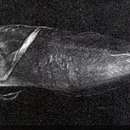Diagnostic Description
provided by Fishbase
Diagnosis: Dorsal fin XII-XIII (usually XII), 13-16, dorsal membrane attached to caudal fin, with distinct notch above last spine, first spine almost equal higher than second; most spines filamentous; anal fin II, 14-17; pectoral rays 15; pelvic fin I, 3-4; caudal fin procurrent rays 8-14. Vertebrae 10 (rarely 11) + 19-21(usually 20); last pleural rib on 11th vertebral centrum, last epipleural rib on 13-17th. Body depth at anal-fin origin 3.6-3.8 in SL. LL, without scales and scalelike flaps; LL tubes 0-5 (rarely up to 8), canal ends below 12th dorsal spine to 11th dorsal ray. Lower lip smooth mesially, plicate laterally. Upper lip crenulae 26-50. Gill rakers 21-27. Cephalic sensory pore system simple. Cirri: supraorbital 4-13 (usually 4-10); nasal 4-34 (usually 6-14); nuchal 22-39 (usually 25-31), in 4 groups, dorsalmost groups sometimes unconnected at their bases, slightly expanded nuchal flap at bases of ventralmost cirri, 2 pores behind nuchal flap. This species of the genus shows the greatest variation and does not have strong modes for meristic characters. Geographic variation for characters midsnout pores and pelvic fin rays; those with 4 pelvic rays have midsnout pores, but it may be present or absent in those with 3 pelvic rays; in some localities both population types are common. Over all brown, with red spots on cheeks and snout but none on body; inner ring of iris yellow, outer red; eyes with yellowish-brown bars beneath; pectoral fins yellowish; caudal fin proximal half brown, distal half with yellow upper rays and reddish lower rays (Ref. 529, 90102). Ophioblennius stage 2.0 cm in SL; overall cream including cirri; no distinct spots (Ref. 529).
- Recorder
- Estelita Emily Capuli
Life Cycle
provided by Fishbase
Oviparous, distinct pairing (Ref. 205). Urogenital orifice of male genital papilla located basally between 2 closely appressed, small, slender filaments on a fleshy swelling behind anus; testes bulbous with length equal to its width (Ref. 529).
- Recorder
- Estelita Emily Capuli
Morphology
provided by Fishbase
Dorsal spines (total): 11 - 13; Dorsal soft rays (total): 13 - 16; Analspines: 2; Analsoft rays: 14 - 17; Vertebrae: 29 - 31
- Recorder
- Estelita Emily Capuli
Trophic Strategy
provided by Fishbase
This species can tolerate a wider range of environmental conditions than others of this genus. Usually found on coral or rocky reefs to 20 m deep (Ref. 529). Found solitary or in small groups (Ref. 90102).
- Recorder
- Grace Tolentino Pablico
Biology
provided by Fishbase
This species can tolerate a wider range of environmental conditions than others of this genus. Adults usually are found on coral or rocky reefs to 20 m deep (Ref. 529). Found solitary or in small groups (Ref. 90102). Oviparous. Eggs are demersal and adhesive (Ref. 205), and are attached to the substrate via a filamentous, adhesive pad or pedestal (Ref. 94114). Larvae are planktonic, often found in shallow, coastal waters (Ref. 94114).
- Recorder
- Estelita Emily Capuli
Importance
provided by Fishbase
fisheries: of no interest; aquarium: commercial
- Recorder
- Estelita Emily Capuli
分布
provided by The Fish Database of Taiwan
分布於印度-西太平洋區,由紅海、馬達加斯加北部經印度-澳洲群島至薩摩亞,北至台灣等。台灣分布於南部及北部等海域。
利用
provided by The Fish Database of Taiwan
小型魚類,僅具學術研究價值。
描述
provided by The Fish Database of Taiwan
體長橢圓形,稍側扁;頭鈍短。鼻鬚及眼上鬚羽狀分支,一連串頸鬚橫貫在頸上,頭背中央的頸鬚有縫而不連續。上唇呈鋸齒緣。D.
XII, 14; A. II, 15; V. I,
3。背鰭棘延長為絲狀,背鰭棘部與軟條間有缺刻,背鰭最後軟條與尾柄相連,臀鰭不與尾柄相連。頭淺褐色,眼眶下方有一暗帶延伸至上唇;體褐色;背鰭、臀鰭黑褐色。
棲地
provided by The Fish Database of Taiwan
主要棲息於淺水域珊瑚礁或岩石區,以藻類、碎屑和小型無脊椎動物為食。
Cirripectes filamentosus
provided by wikipedia EN
- license
- cc-by-sa-3.0
- copyright
- Wikipedia authors and editors
Cirripectes filamentosus: Brief Summary
provided by wikipedia EN
Cirripectes filamentosus, the filamentous blenny, is a species of combtooth blenny found in coral reefs in the western Pacific and Indian oceans. This species reaches a length of 9 centimetres (3.5 in) TL.
- license
- cc-by-sa-3.0
- copyright
- Wikipedia authors and editors
Description
provided by World Register of Marine Species
Usually found on coral or rocky reefs in shallow water to about 20 m.
Froese, R. & D. Pauly (Editors). (2023). FishBase. World Wide Web electronic publication. version (02/2023).
- license
- cc-by-4.0
- copyright
- WoRMS Editorial Board

